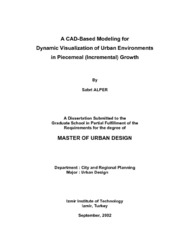Please use this identifier to cite or link to this item:
https://hdl.handle.net/11147/3077Full metadata record
| DC Field | Value | Language |
|---|---|---|
| dc.contributor.advisor | Serim, Muharrem Erkal | en |
| dc.contributor.author | Alper, Sabri | - |
| dc.date.accessioned | 2014-07-22T13:50:50Z | - |
| dc.date.available | 2014-07-22T13:50:50Z | - |
| dc.date.issued | 2002 | en |
| dc.identifier.uri | http://hdl.handle.net/11147/3077 | - |
| dc.description | Thesis (Master)--Izmir Institute of Technology, City and Regional Planning, Izmir, 2002 | en |
| dc.description | Includes bibliographical references (leaves: 114-122) | en |
| dc.description | Text in English; Abstract: Turkish and English | en |
| dc.description | xi, 122 leaves | en |
| dc.description.abstract | Visualization is inherent to the conduct of urban design as a direct connection between the designer and three dimensional reality of urban settlements. Visualization of urban environments and urban design projects is vital, since most designers prefer to understand place and context through visualization. The reasons for visualization in urban design can be classified under three headings: .visual thinking, design communication and testing mechanism. Digital revolution. has improved computer use in urban design, as in many other fields. Dynamic computer models can present an ideal environment to visualize the change in respect to time. Digital tools are much more efficient than conventional methods in explaining the growth and change of urban environments. Especially, incremental growth requires features not found in .static/analog. media. Christopher Alexander and his colleagues, in their book .A New Theory of Urban Design., tried to justify their ideas about piecemeal growth by an experiment. The analog methods, such as physical models, two-dimensional diagrams, have been used to conduct the experiment and to convey their ideas about the design process. This thesis tries to produce a .dynamic/digital. model that could be utilized in their experiment instead of static/analog methods. Spatial data should be considered as dynamic, or changing identities rather than as simple, static features. Time is an example of a dynamic component of a spatial data set. Recent technological developments are increasing computer hardware and software capabilities so that this dynamic aspect of data can be accounted for by today.s systems. Dynamic data have not been a great concern in digital technologies for many years, but today changing patterns and dimensions are becoming more important. | en |
| dc.language.iso | en | en_US |
| dc.publisher | Izmir Institute of Technology | en |
| dc.rights | info:eu-repo/semantics/openAccess | en_US |
| dc.subject.lcc | HT165.5 A47 2002 | en |
| dc.subject.lcsh | City planning | en |
| dc.subject.lcsh | Visualization | en |
| dc.subject.lcsh | Computer-aided design | en |
| dc.subject.lcsh | Geographic information systems | en |
| dc.title | A CAD-based modeling for dynamic visualization of urban environments in piecemeal (incremental) growth | en_US |
| dc.type | Master Thesis | en_US |
| dc.institutionauthor | Alper, Sabri | - |
| dc.department | Thesis (Master)--İzmir Institute of Technology, City and Regional Planning | en_US |
| dc.relation.publicationcategory | Tez | en_US |
| item.languageiso639-1 | en | - |
| item.fulltext | With Fulltext | - |
| item.openairecristype | http://purl.org/coar/resource_type/c_18cf | - |
| item.openairetype | Master Thesis | - |
| item.grantfulltext | open | - |
| item.cerifentitytype | Publications | - |
| Appears in Collections: | Master Degree / Yüksek Lisans Tezleri Sürdürülebilir Yeşil Kampüs Koleksiyonu / Sustainable Green Campus Collection | |
Files in This Item:
| File | Description | Size | Format | |
|---|---|---|---|---|
| T000149.pdf | MasterThesis | 7.47 MB | Adobe PDF |  View/Open |
CORE Recommender
Page view(s)
110
checked on Jul 22, 2024
Download(s)
24
checked on Jul 22, 2024
Google ScholarTM
Check
Items in GCRIS Repository are protected by copyright, with all rights reserved, unless otherwise indicated.